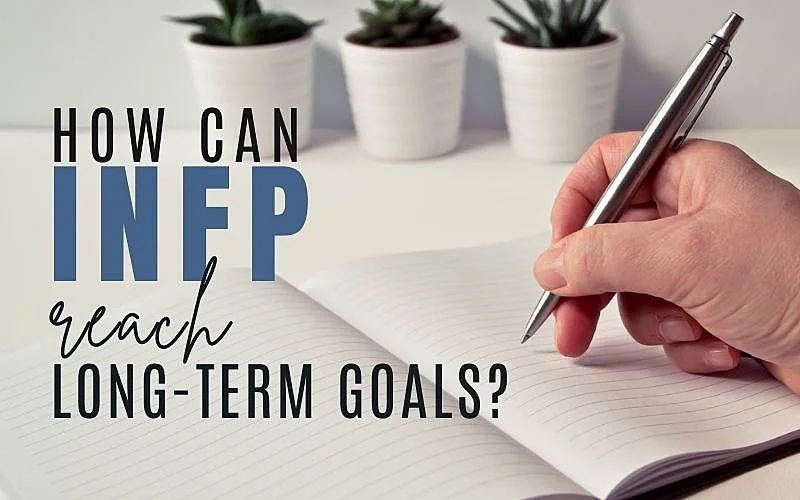INFPs are a passionate and creative bunch. Amazingly, this personality type can carry out transformative idealism to the world. But while these free spirits are also known as idea generators, unfortunately, procrastination and sticking with goals are the villains to unleashing their utmost potential.
INFP goals may often come as too ambitious, unclear, or ever-changing. Well, it’s not that their goals aren’t workable. However, many INFPs submit to procrastination and indecision which leave their goals buried and forgotten in the long run.
But since INFPs are profuse dreamers, plans inevitably spring up from time to time. That said, to handle their boatloads of plans, these gentle ones should set effective methods for goal-setting. But how can INFP achieve goals and be fulfilled about them?
In this post, let’s weigh up some tips and steps for a guided INFP goal-setting. Let’s split them into two parts:
- Step by Step Process on How INFPs Can Reach Goals
- Tips on How INFP Can Reach Long-Term Goals
5 Steps on INFP Goal-setting
These are the steps I use whenever I’m setting my goals. Let’s start:
Step #1: List down your active and passive goals.
This is the most exciting part, at least for me (and every INFP) – the planning! To start, grab your pen and paper and list down what you wanted to achieve, reach, or change. Write down your active and passive goals.
Active goals are actionable tasks where you have overall power and control to actualize them. These goals involve a regular conscious effort. Active goals are specific and time-bound.
Passive goals, on the other hand, are the possible results you can achieve but you don’t exactly have full control of when it’s gonna happen.
Let’s say, if your passive goal is to be a healthier version of yourself, then, your active goals must be more specific such as exercising for 15 minutes, drinking 6-8 glasses of water, and sleeping 8 hours every day.
Now, grab that pen and paper and write the goal you wanted to achieve. Here are a few examples:
| Passive Goals | Active Goals |
|
Be more creative. |
|
|
Save more money. |
|
| Finish a novel. |
|
Now that you have your goals all set up. Let’s move to the next step.
Step #2: Review your past and present capabilities.
Are you done writing your goals? Now let’s set some reality checks.
INFPs love imagining the grand finale of their plans. You might have envisioned yourself as successful, helpful to others, or even popular after reaching that goal. (Same here.) But before such daydreaming completely enchants you, let’s do some reality checks.
Review what you did in the past few years. What situations worked for you and what didn’t? As an INFP, what values do you uphold? What are you good at? What lessons did you carry from the past?
In this step, you have to dig deep into your routine and preferences.
When scheduling, avoid empty promises such as “From now on, I will write every day!” Instead, look back and evaluate your faculties, patience, and abilities first.
Can you really commit to writing every day or will it effectively cater to your availability if you do it twice a week?
Tweak your goals to fit your current capabilities.
In my case, after completing writing projects, I usually give myself 1-2 days to cool down before I accept writing projects again. I do this to restructure my thoughts and recover the creative juices. You should be aware of how you function, too.
Step#3: Be more concerned with the regular output rather than the final outcome.
Focus on what you need to accomplish every day, rather than constantly checking what’s to come out of it.
Pay attention to the baby steps. Instead of hyping yourself with unspecific wishes like, “I’m gonna be a better painter,” change that into little actionable steps like “I will practice painting a flower today.” Take one task at a time. Accomplish tasks day by day, week by week.
Also, if there’s one thing INFPs must eliminate, it’s the love for instant gratification. Keep in mind that it may take months to years of practice and constant efforts to realize a significant return. Be patient.

Focus on your regular output, rather than the final outcome.
Regular output > Final outcome
As I’ve always told myself, “if I put in the work, it’s impossible to not reap fruits in the future.” Everything you do today will impact the future version of you.
Whether you’re growing a skill, building a habit, or reaching milestones, as long as you don’t stop working on it, you will eventually reach completion. Again, scratch your attachment with instant gratification. Great things take months to years to build.
Step#4: Create an adaptable and flexible schedule.
Now that you have a realistic goal, let’s set your schedule.
As an INFP myself, I suggest not to overwork yourself. Don’t exhaust yourself to the point that you’d burn out and start to hate what you’re doing. When I overworked myself back then, I was left with an exhausted soul.
Instead, train your mind to do one little goal at a time. Little consistent steps every week is better than depleting motivation. It may be slow but this method will surely meet completion.
One more thing I observed about being an INFP is my timelessness.
What does “timelessness” mean to an INFP? It’s that, INFPs don’t follow through with the schedule. Usually, they accomplish tasks whenever they feel like doing them or when there’s a deadline.
I might be doing my tasks at 2 AM or 9 AM or whenever, unlike INFJs who follow a linear and structured schedule.
That said, as an INFP, my strategy is to list down all my tasks for the week. And it’s up to me to do it anytime and any day I want, as long as everything’s done within my deadline.
For INFP goal-setting, give yourself realistic time allowances and flexibility.
Step#5: Build habits.
Often, people talk about having grit or discipline to reach their goals. But truth is, discipline is a conscious effort at first but once you built a habit, reaching goals would be a breeze.
Because of INFP’s introverted Sensing (Si) as a tertiary function, other people, things, skills, and situations need ample time to grow on INFPs. With constant repetition, tasks become part of their routine and stick to their long-term memory.
According to a study, it takes an average of 66 days to build a habit. That said, push yourself to work for more or less 66 days. Show up even if it makes you uncomfortable. In short, hang in there for 2-3 months. Once you pick up the habit, you can lie low and go back to your preferred schedule.
I’ve been professionally writing since 2018 but I had an on-off relationship with this craft. Before, I write within weeks to months intervals. It’s so… yup, lazy.
But when I decided to join a 30-day writing challenge, I forced myself to show up every day and continued despite wanting to give up. It was beneficial, though, because I eventually picked up the habit. Now, I must tell you, I can’t let a week pass without scribbling my thoughts.
You have to show up regularly until you build the habit – even when it sucks and looks like you’re not getting anywhere.
Tips on How INFP Can Achieve Goals
We’re done with the first steps on how INFPs can reach goals. Now, here are additional tips to remember. Don’t give up to soon and take note of these:
Tip#1: Boredom occurs and it’s normal.

Unfortunately, when boredom strikes, INFPs often mistake it as a lack of passion so they start to drop their plans.
But the truth is, everyone will eventually reach a plateau of boredom. Even I get bored at things I’m passionate about. But we must remind ourselves that every long-term goal will face high and low days. Remember, boredom doesn’t equate to failure or a lack of passion.
When things get boring, try to listen to other people’s testimonies or success stories or gather new information to bring back the motivation. Recall why you’re doing this goal in the first place.
Tip#2: Goals are bound to change, improve, and be redirected.
Unfortunately for INFPs, setting goals isn’t immediate. They’re not the type to wake up and immediately stick on a path.
Instead, INFPs will constantly idealize opportunities, gather information, and try every experience they can until their goals shift shapes and start to mirror their truest identity.
The things you want today may not be what you want tomorrow. INFPs always test the waters to identify what truly works for them. But it’s alright. Refine and redefine your goals.
Tip#3: Gain experience.
Some people would advise INFPs to “visualize what it feels like” when setting goals. Partly, it’s helpful. But for INFPs to truly achieve the visualized goal, experience will be their best friend. It makes their decisions and goals firmer.
INFP’s dominant judging function is introverted feeling (Fi). They judge based on what aligns with their values. However, when INFPs lack experience (Si) and rely too much on visions (Ne) they may end up misjudging the situation.
Remember the events that you disliked at first but eventually turned out good? That’s because visions alone aren’t as reliable as using your experiences as the basis for decision-making.
You may also like:
Tip#4: Think long-term.
Resolve to yourself that goals don’t end in a day or week. I can’t stress this enough.
Give yourself months or even years to adjust and refine your goals. Let yourself grow in strength and skills as you trudge in the process. Once you put in the hard work one step at a time, it leads INFPs to an inevitable completion.
Wrap up
5 Steps on how INFP can reach long-term goals:
- List down your goals.
- Check your capabilities: time availability, skill, and finances.
- Focus on the regular output, rather than the outcome.
- Set a flexible schedule (a schedule you will surely follow)
- Build habits for at least 2-3 months.
Now, here are the tips!
- To feel bored is normal.
- Goals are bound to change and be refined.
- Experience will make you more decisive than just visualization.
- Think long-term and refrain from wanting instant gratification.
-M.Mathias
Book Recommendation for Building Habits:

Buy on Amazon or Get Free Audiobook with Audible Trial
You may also like:
- How Can INFP Become Successful?
- 6 Tips to Deal with Introvert Procrastination
- How Can INFP Stop Overthinking?

